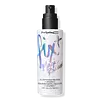What's inside
What's inside
 Key Ingredients
Key Ingredients

 Benefits
Benefits

 Concerns
Concerns

 Ingredients Side-by-side
Ingredients Side-by-side

Water
Skin ConditioningAlcohol Denat.
AntimicrobialPvp
Emulsion StabilisingDimethicone PEG-7 Phosphate
CleansingPPG-3 Benzyl Ether Myristate
EmollientPolyhydroxystearic Acid
EmulsifyingDipropylene Glycol
HumectantIsononyl Isononanoate
EmollientEthylhexyl Isononanoate
EmollientCaprylyl Glycol
EmollientSodium Cocamidopropyl Pg-Dimonium Chloride Phosphate
CleansingMethyl Methacrylate Crosspolymer
Glycereth-5 Lactate
EmollientPhenylpropanol
MaskingPropanediol
SolventMethyl Diisopropyl Propionamide
MaskingSodium Hydroxide
BufferingParfum
MaskingAloe Barbadensis Leaf Juice
Skin ConditioningMaltodextrin
AbsorbentPoloxamer 407
EmulsifyingPentaerythrityl Tetra-Di-T-Butyl Hydroxyhydrocinnamate
AntioxidantTocopherol
AntioxidantPotassium Sorbate
PreservativeSodium Benzoate
MaskingWater, Alcohol Denat., Pvp, Dimethicone PEG-7 Phosphate, PPG-3 Benzyl Ether Myristate, Polyhydroxystearic Acid, Dipropylene Glycol, Isononyl Isononanoate, Ethylhexyl Isononanoate, Caprylyl Glycol, Sodium Cocamidopropyl Pg-Dimonium Chloride Phosphate, Methyl Methacrylate Crosspolymer, Glycereth-5 Lactate, Phenylpropanol, Propanediol, Methyl Diisopropyl Propionamide, Sodium Hydroxide, Parfum, Aloe Barbadensis Leaf Juice, Maltodextrin, Poloxamer 407, Pentaerythrityl Tetra-Di-T-Butyl Hydroxyhydrocinnamate, Tocopherol, Potassium Sorbate, Sodium Benzoate
Water
Skin ConditioningButylene Glycol
HumectantGlycerin
HumectantPolysorbate 20
EmulsifyingTocopheryl Acetate
AntioxidantSodium Hyaluronate
HumectantArginine
MaskingCaffeine
Skin ConditioningAspergillus Ferment
Skin ConditioningRosa Rubiginosa Seed Oil
EmollientPorphyra Yezoensis Extract
Skin ConditioningGentiana Lutea Root Extract
Skin ConditioningPalmaria Palmata Extract
Skin ProtectingAlgae Extract
EmollientYeast Extract
Skin ConditioningHydrolyzed Rice Bran Extract
Skin ConditioningDipotassium Glycyrrhizate
HumectantSodium Polyaspartate
HumectantSilk Powder
Skin ConditioningPhospholipids
Skin ConditioningAscorbyl Glucoside
AntioxidantSalicylic Acid
MaskingTrehalose
HumectantTourmaline
Jojoba Wax PEG-120 Esters
Potassium Hydroxide
BufferingCaprylyl Glycol
EmollientHexylene Glycol
EmulsifyingPentylene Glycol
Skin ConditioningCitric Acid
BufferingHydroxyethyl Urea
HumectantParfum
MaskingLimonene
PerfumingBHT
AntioxidantDisodium EDTA
Sodium Citrate
BufferingPhenoxyethanol
PreservativePotassium Sorbate
PreservativeChlorphenesin
AntimicrobialSodium Benzoate
MaskingWater, Butylene Glycol, Glycerin, Polysorbate 20, Tocopheryl Acetate, Sodium Hyaluronate, Arginine, Caffeine, Aspergillus Ferment, Rosa Rubiginosa Seed Oil, Porphyra Yezoensis Extract, Gentiana Lutea Root Extract, Palmaria Palmata Extract, Algae Extract, Yeast Extract, Hydrolyzed Rice Bran Extract, Dipotassium Glycyrrhizate, Sodium Polyaspartate, Silk Powder, Phospholipids, Ascorbyl Glucoside, Salicylic Acid, Trehalose, Tourmaline, Jojoba Wax PEG-120 Esters, Potassium Hydroxide, Caprylyl Glycol, Hexylene Glycol, Pentylene Glycol, Citric Acid, Hydroxyethyl Urea, Parfum, Limonene, BHT, Disodium EDTA, Sodium Citrate, Phenoxyethanol, Potassium Sorbate, Chlorphenesin, Sodium Benzoate
 Reviews
Reviews

Ingredients Explained
These ingredients are found in both products.
Ingredients higher up in an ingredient list are typically present in a larger amount.
Caprylyl Glycol is a humectant and emollient, meaning it attracts and preserves moisture.
It is a common ingredient in many products, especially those designed to hydrate skin. The primary benefits are retaining moisture, skin softening, and promoting a healthy skin barrier.
Though Caprylyl Glycol is an alcohol derived from fatty acids, it is not the kind that can dry out skin.
This ingredient is also used as a preservative to extend the life of products. It has slight antimicrobial properties.
Learn more about Caprylyl GlycolParfum is a catch-all term for an ingredient or more that is used to give a scent to products.
Also called "fragrance", this ingredient can be a blend of hundreds of chemicals or plant oils. This means every product with "fragrance" or "parfum" in the ingredients list is a different mixture.
For instance, Habanolide is a proprietary trade name for a specific aroma chemical. When used as a fragrance ingredient in cosmetics, most aroma chemicals fall under the broad labeling category of “FRAGRANCE” or “PARFUM” according to EU and US regulations.
The term 'parfum' or 'fragrance' is not regulated in many countries. In many cases, it is up to the brand to define this term.
For instance, many brands choose to label themselves as "fragrance-free" because they are not using synthetic fragrances. However, their products may still contain ingredients such as essential oils that are considered a fragrance by INCI standards.
One example is Calendula flower extract. Calendula is an essential oil that still imparts a scent or 'fragrance'.
Depending on the blend, the ingredients in the mixture can cause allergies and sensitivities on the skin. Some ingredients that are known EU allergens include linalool and citronellol.
Parfum can also be used to mask or cover an unpleasant scent.
The bottom line is: not all fragrances/parfum/ingredients are created equally. If you are worried about fragrances, we recommend taking a closer look at an ingredient. And of course, we always recommend speaking with a professional.
Learn more about ParfumPotassium Sorbate is a preservative used to prevent yeast and mold in products. It is commonly found in both cosmetic and food products.
This ingredient comes from potassium salt derived from sorbic acid. Sorbic acid is a natural antibiotic and effective against fungus.
Both potassium sorbate and sorbic acid can be found in baked goods, cheeses, dried meats, dried fruit, ice cream, pickles, wine, yogurt, and more.
You'll often find this ingredient used with other preservatives.
Learn more about Potassium SorbateSodium Benzoate is a preservative. It's used in both cosmetic and food products to inhibit the growth of mold and bacteria. It is typically produced synthetically.
Both the US FDA and EU Health Committee have approved the use of sodium benzoate. In the US, levels of 0.1% (of the total product) are allowed.
Sodium benzoate works as a preservative by inhibiting the growth of bacteria inside of cells. It prevents the cell from fermenting a type of sugar using an enzyme called phosphofructokinase.
It is the salt of benzoic acid. Foods containing sodium benzoate include soda, salad dressings, condiments, fruit juices, wines, and snack foods.
Studies for using ascorbic acid and sodium benzoate in cosmetics are lacking, especially in skincare routines with multiple steps.
We always recommend speaking with a professional, such as a dermatologist, if you have any concerns.
Learn more about Sodium BenzoateWater. It's the most common cosmetic ingredient of all. You'll usually see it at the top of ingredient lists, meaning that it makes up the largest part of the product.
So why is it so popular? Water most often acts as a solvent - this means that it helps dissolve other ingredients into the formulation.
You'll also recognize water as that liquid we all need to stay alive. If you see this, drink a glass of water. Stay hydrated!
Learn more about Water